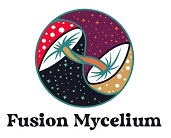
Spawn to Bulk
Preparation of Materials:
- Psilocybin mushroom spawn (colonized substrate)
- Bulk substrate (e.g., pasteurized straw, compost, or a mix of coir and vermiculite)
- Clean, sanitized containers for spawning (e.g., plastic tubs or trays)
- Clean gloves
- A clean, well-ventilated workspace
Prepare Bulk Substrate:
If using pasteurized straw or compost, ensure it has been properly prepared according to established protocols for mushroom cultivation. The substrate should be free of contaminants and at the appropriate moisture content. If using a mix of coir and vermiculite, hydrate the mixture to the desired moisture level. It should be damp but not dripping wet.
Prepare Spawning Containers:
Clean and sanitize the containers thoroughly to prevent contamination. Use a disinfectant or a bleach solution diluted with water. Allow the containers to dry completely before adding the substrate.
Spawn Inoculation:
Wear clean gloves to prevent introducing contaminants.
Layer a thin substrate base in the bottom of the spawning container.
Break up the colonized mushroom spawn into small pieces, ensuring even distribution throughout the substrate.
Layer the colonized spawn evenly over the substrate base, covering the entire surface area.
Repeat the process, alternating layers of spawn and substrate until the container is filled to the desired depth.
Mixing and Integration:
Gently mix the colonized spawn and substrate together using clean hands or a sanitized tool. Ensure thorough integration without compacting the substrate.
The goal is to evenly distribute the spawn throughout the bulk substrate, promoting colonization and mycelial growth.
Incubation:
Cover the spawning container with a clean lid or plastic wrap to maintain humidity and prevent contamination.
Place the container in a warm, dark location with consistent temperature and humidity conditions suitable for mycelial growth.
Monitor the substrate for signs of colonization, such as white mycelium spreading throughout the substrate. This process typically takes several weeks.
Colonization Monitoring:
Check the substrate regularly for any signs of contamination, such as mold or unusual odors. If contamination is detected, remove affected areas immediately to prevent further spread.
Maintain proper environmental conditions throughout the colonization process to support healthy mycelial growth.
Fruiting:
Once the substrate is fully colonized with mycelium, initiate the fruiting stage by exposing it to fresh air and light.
Provide adequate ventilation and humidity to encourage the formation of mushroom fruit bodies.
Monitor the fruiting process closely, adjusting environmental conditions as needed to optimize mushroom growth and development.
Harvesting:
Harvest mature mushroom fruit bodies as they develop, using clean hands or sanitized tools to minimize contamination.
Cut or twist the mushrooms at the base to remove them from the substrate.
Harvest regularly to promote continuous fruiting and maximize yield.
Cleanup and Maintenance:
Dispose of any unused substrate and contaminated materials properly to prevent the spread of contaminants.
Clean and sanitize all equipment and surfaces thoroughly after use to maintain a sterile cultivation environment for future batches.


I love what you guys tend to be up too. This type of clever work and coverage!
Keep up the fantastic works guys I’ve added you guys
to my personal blogroll.
Hey James!
That’s much appreciated, we indeed love our work and are very happy to reach you!
Thank you for those kinds words.
You’ve made some good points there. I checked on the net to find out more about the issue and found most individuals will go along with your views on this site.